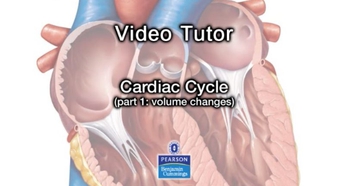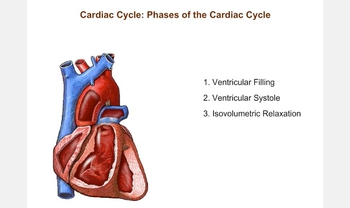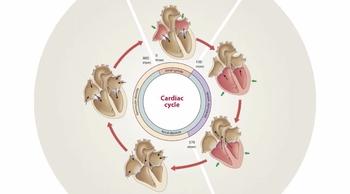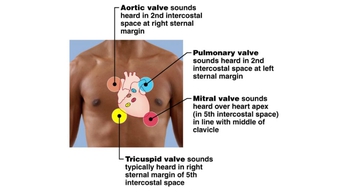Blood flows through the heart in one direction, from atria to ventricles and out large arteries. This is made possible by pressure changes caused by alternating contraction and relaxation of the heart. Blood moves through the heart according to pressure gradients, always from an area of high pressure to an area of lower pressure. Let's examine pressure changes in the heart throughout each phase of the cardiac cycle. The following graph depicts pressure changes in the heart chambers and arteries through time. This graph depicts pressure changes on the left side of the heart only. The left side of the heart pumps blood through the body's tissues, which requires tremendous force. The right side of the heart services the pulmonary circuit which requires less pressure. The graph depicts pressure changes throughout the cardiac cycle in the left atrium, indicated by the purple line, the left ventricle, indicated by the blue line, and the aorta, indicated by the green line. This pressure graph depicts slightly more than one cardiac cycle. We'll arbitrarily decide to begin our cardiac cycle here at the first arrow, right before the small increase in atrial and ventricle pressure. The second arrow then indicates the end of one cardiac cycle. We could have begun our cardiac cycle at some other point, but this range will be convenient because it occupies the center of our graph. We begin with atrial contraction where the ventricle is relaxed and filling with blood. During this phase, atrial pressure indicated by the purple line is higher than ventricle pressure indicated by the blue line. Blood always flows through the heart according to pressure gradients, from high to low pressure. We'll draw an arrow from the arterial pressure trace to the ventricle trace to indicate this pressure gradient. Blood moves from high pressure in the atrium to an area of lower pressure in the ventricle. Based on pressures alone, we might expect blood flow from the aorta to the atrium, but the aorta and atrium are not connected so blood cannot flow between these two regions. Similarly, we might expect blood to flow from the aorta to the ventricle. However, the semilunar valve prevents this from happening. Heart valves, like the semilunar valve and the AV valve, prevent backward flow of blood through the heart even when pressure gradients favor such flow. Once the ventricle is filled with blood it begins to contract, this indicates the start of isovolumetric contraction. As the ventricle contracts, ventricular pressure begins to rise which forces the AV valve closed. Valve events always occur at the intersection of pressure traces. So, for example, the AV valve closes when the ventricle trace crosses the atrium trace. Closure of the AV valve prevents blood from flowing backward into the atria which is now at a lower pressure than the ventricle. Pressure is not yet high enough in the ventricle to open the semilunar valve leading into the aorta. The semilunar valve will not open until the ventricle trace crosses the aorta trace in the next phase. Therefore, blood cannot flow backward through the heart while the semilunar valve is closed. During this phase, all valves into and out of the ventricle are closed. Eventually, pressure in the ventricle exceeds pressure in the aorta, forcing the semilunar valve open, allowing blood to be ejected from the ventricle into the aorta. This is called ventricular ejection. Notice, blood is flowing from an area of high pressure in the ventricle to an area of lower pressure in the aorta. Although the pressure difference between the ventricle and aorta become small, the semilunar valve remains open and blood continues to flow out of the ventricle. Once pressure in the ventricle drops below the pressure in the aorta, the semilunar valve shuts preventing blood from flowing backward into the ventricle. The sudden closure of the semilunar valve results in blood from the aorta rebounding off the closed valve, causing a transient increase in aortic pressure. This forms a notch in aortic pressure trace known as the dicrotic notch. Once again, the ventricles are completely closed chambers. The semilunar valves and the AV valves are closed. This represents isovolumetric relaxation. As the ventricle continues to relax, ventricular pressures drops below atrial pressure. This pressure change results in the AV valve opening allowing blood to flow from the atrium which is at a higher pressure, into the ventricle at a lower pressure. This marks the beginning of ventricular filling and another cardiac cycle will soon follow. Throughout the phases of the cardiac cycle, blood flows from an area of higher pressure to an area of lower pressure through one-way valves. Pressure gradients are caused by alternating contractions and relaxations of heart chambers. Blood flows into the ventricle during atrial contraction, from the ventricle into the aorta during ventricular ejection, and from the atrium to ventricle during ventricular filling. The opening and closing of one-way valves always occurs at the intersection of pressure traces on the graph. The valves open to allow blood to move through the heart from a high to low pressure. The valves close to prevent blood from flowing backward through the heart, even when pressure gradients favor such flow.
Table of contents
- 1. Introduction to Anatomy & Physiology5h 40m
- What is Anatomy & Physiology?20m
- Levels of Organization13m
- Variation in Anatomy & Physiology12m
- Introduction to Organ Systems27m
- Homeostasis9m
- Feedback Loops11m
- Feedback Loops: Negative Feedback19m
- Feedback Loops: Positive Feedback11m
- Anatomical Position7m
- Introduction to Directional Terms3m
- Directional Terms: Up and Down9m
- Directional Terms: Front and Back6m
- Directional Terms: Body Sides12m
- Directional Terms: Limbs6m
- Directional Terms: Depth Within the Body4m
- Introduction to Anatomical Terms for Body Regions3m
- Anatomical Terms for the Head and Neck8m
- Anatomical Terms for the Front of the Trunk8m
- Anatomical Terms for the Back9m
- Anatomical Terms for the Arm and Hand9m
- Anatomical Terms for the Leg and Foot15m
- Review- Using Anatomical Terms and Directions12m
- Abdominopelvic Quadrants and Regions19m
- Anatomical Planes & Sections17m
- Organization of the Body: Body Cavities13m
- Organization of the Body: Serous Membranes14m
- Organization of the Body: Serous Membrane Locations8m
- Organization of the Body: Thoracic Cavity8m
- Organization of the Body: Abdominopelvic Cavity12m
- 2. Cell Chemistry & Cell Components12h 37m
- Atoms- Smallest Unit of Matter57m
- Isotopes39m
- Introduction to Chemical Bonding19m
- Covalent Bonds40m
- Noncovalent Bonds5m
- Ionic Bonding37m
- Hydrogen Bonding19m
- Introduction to Water7m
- Properties of Water- Cohesion and Adhesion7m
- Properties of Water- Density8m
- Properties of Water- Thermal14m
- Properties of Water- The Universal Solvent17m
- Acids and Bases12m
- pH Scale21m
- Carbon8m
- Functional Groups9m
- Introduction to Biomolecules2m
- Monomers & Polymers11m
- Carbohydrates23m
- Proteins25m
- Nucleic Acids34m
- Lipids28m
- Microscopes10m
- Prokaryotic & Eukaryotic Cells26m
- Introduction to Eukaryotic Organelles16m
- Endomembrane System: Protein Secretion34m
- Endomembrane System: Digestive Organelles15m
- Mitochondria & Chloroplasts21m
- Endosymbiotic Theory10m
- Introduction to the Cytoskeleton10m
- Cell Junctions8m
- Biological Membranes10m
- Types of Membrane Proteins7m
- Concentration Gradients and Diffusion9m
- Introduction to Membrane Transport14m
- Passive vs. Active Transport13m
- Osmosis33m
- Simple and Facilitated Diffusion17m
- Active Transport30m
- Endocytosis and Exocytosis15m
- 3. Energy & Cell Processes10h 7m
- Introduction to Energy15m
- Laws of Thermodynamics15m
- Chemical Reactions9m
- ATP20m
- Enzymes14m
- Enzyme Activation Energy9m
- Enzyme Binding Factors9m
- Enzyme Inhibition10m
- Introduction to Metabolism8m
- Redox Reactions15m
- Introduction to Cellular Respiration22m
- Types of Phosphorylation11m
- Glycolysis19m
- Pyruvate Oxidation8m
- Krebs Cycle16m
- Electron Transport Chain14m
- Chemiosmosis7m
- Review of Aerobic Cellular Respiration19m
- Fermentation & Anaerobic Respiration23m
- Introduction to Cell Division22m
- Organization of DNA in the Cell17m
- Introduction to the Cell Cycle7m
- Interphase18m
- Phases of Mitosis48m
- Cytokinesis16m
- Cell Cycle Regulation18m
- Review of the Cell Cycle7m
- Cancer13m
- Introduction to DNA Replication22m
- DNA Repair7m
- Central Dogma7m
- Introduction to Transcription20m
- Steps of Transcription19m
- Genetic Code25m
- Introduction to Translation30m
- Steps of Translation23m
- Post-Translational Modification6m
- 4. Tissues & Histology10h 3m
- Introduction to Tissues & Histology16m
- Introduction to Epithelial Tissue24m
- Characteristics of Epithelial Tissue37m
- Structural Naming of Epithelial Tissue19m
- Simple Epithelial Tissues1h 2m
- Stratified Epithelial Tissues55m
- Identifying Types of Epithelial Tissue32m
- Glandular Epithelial Tissue26m
- Introduction to Connective Tissue36m
- Classes of Connective Tissue8m
- Introduction to Connective Tissue Proper40m
- Connective Tissue Proper: Loose Connective Tissue56m
- Connective Tissue Proper: Dense Connective Tissue49m
- Specialized Connective Tissue: Cartilage44m
- Specialized Connective Tissue: Bone12m
- Specialized Connective Tissue: Blood9m
- Introduction to Muscle Tissue7m
- Types of Muscle Tissue45m
- Introduction to Nervous Tissue8m
- Nervous Tissue: The Neuron8m
- 5. Integumentary System2h 20m
- 6. Bones & Skeletal Tissue2h 16m
- An Introduction to Bone and Skeletal Tissue18m
- Gross Anatomy of Bone: Compact and Spongy Bone7m
- Gross Anatomy of Bone: Periosteum and Endosteum11m
- Gross Anatomy of Bone: Bone Marrow8m
- Gross Anatomy of Bone: Short, Flat, and Irregular Bones5m
- Gross Anatomy of Bones - Structure of a Long Bone23m
- Microscopic Anatomy of Bones - Bone Matrix9m
- Microscopic Anatomy of Bones - Bone Cells25m
- Microscopic Anatomy of Bones - The Osteon17m
- Microscopic Anatomy of Bones - Trabeculae9m
- 7. The Skeletal System2h 35m
- 8. Joints2h 17m
- 9. Muscle Tissue2h 33m
- 10. Muscles1h 11m
- 11. Nervous Tissue and Nervous System1h 35m
- 12. The Central Nervous System1h 6m
- 13. The Peripheral Nervous System1h 26m
- Introduction to the Peripheral Nervous System5m
- Organization of Sensory Pathways16m
- Introduction to Sensory Receptors5m
- Sensory Receptor Classification by Modality6m
- Sensory Receptor Classification by Location8m
- Proprioceptors7m
- Adaptation of Sensory Receptors8m
- Introduction to Reflex Arcs13m
- Reflex Arcs15m
- 14. The Autonomic Nervous System1h 38m
- 15. The Special Senses2h 41m
- 16. The Endocrine System2h 48m
- 17. The Blood1h 22m
- 18. The Heart1h 42m
- 19. The Blood Vessels3h 35m
- 20. The Lymphatic System3h 16m
- 21. The Immune System14h 37m
- Introduction to the Immune System10m
- Introduction to Innate Immunity17m
- Introduction to First-Line Defenses5m
- Physical Barriers in First-Line Defenses: Skin13m
- Physical Barriers in First-Line Defenses: Mucous Membrane9m
- First-Line Defenses: Chemical Barriers24m
- First-Line Defenses: Normal Microbiota7m
- Introduction to Cells of the Immune System15m
- Cells of the Immune System: Granulocytes28m
- Cells of the Immune System: Agranulocytes26m
- Introduction to Cell Communication5m
- Cell Communication: Surface Receptors & Adhesion Molecules16m
- Cell Communication: Cytokines27m
- Pattern Recognition Receptors (PRRs)48m
- Introduction to the Complement System24m
- Activation Pathways of the Complement System23m
- Effects of the Complement System23m
- Review of the Complement System13m
- Phagocytosis17m
- Introduction to Inflammation18m
- Steps of the Inflammatory Response28m
- Fever8m
- Interferon Response25m
- Review Map of Innate Immunity
- Introduction to Adaptive Immunity32m
- Antigens12m
- Introduction to T Lymphocytes38m
- Major Histocompatibility Complex Molecules20m
- Activation of T Lymphocytes21m
- Functions of T Lymphocytes25m
- Review of Cytotoxic vs Helper T Cells13m
- Introduction to B Lymphocytes27m
- Antibodies14m
- Classes of Antibodies35m
- Outcomes of Antibody Binding to Antigen15m
- T Dependent & T Independent Antigens21m
- Clonal Selection20m
- Antibody Class Switching17m
- Affinity Maturation14m
- Primary and Secondary Response of Adaptive Immunity21m
- Immune Tolerance28m
- Regulatory T Cells10m
- Natural Killer Cells16m
- Review of Adaptive Immunity25m
- 22. The Respiratory System3h 20m
- 23. The Digestive System2h 5m
- 24. Metabolism and Nutrition4h 0m
- Essential Amino Acids5m
- Lipid Vitamins19m
- Cellular Respiration: Redox Reactions15m
- Introduction to Cellular Respiration22m
- Cellular Respiration: Types of Phosphorylation14m
- Cellular Respiration: Glycolysis19m
- Cellular Respiration: Pyruvate Oxidation8m
- Cellular Respiration: Krebs Cycle16m
- Cellular Respiration: Electron Transport Chain14m
- Cellular Respiration: Chemiosmosis7m
- Review of Aerobic Cellular Respiration18m
- Fermentation & Anaerobic Respiration23m
- Gluconeogenesis16m
- Fatty Acid Oxidation20m
- Amino Acid Oxidation17m
- 25. The Urinary System2h 39m
- 26. Fluid and Electrolyte Balance, Acid Base Balance Coming soon
- 27. The Reproductive System2h 5m
- 28. Human Development1h 21m
- 29. Heredity Coming soon
18. The Heart
Cardiac Cycle
Video duration:
6mPlay a video:
Related Videos
Related Practice
















